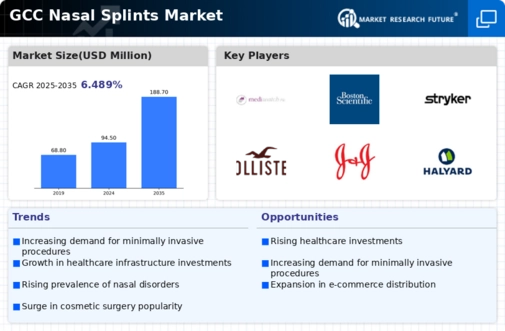Supportive Regulatory Framework
A supportive regulatory framework in the GCC region is fostering growth in the nasal splints market. Regulatory bodies are streamlining the approval processes for medical devices, which encourages manufacturers to introduce new products. This environment of regulatory support is crucial for the development and distribution of innovative nasal splints. As regulations become more favorable, companies are likely to invest in the nasal splints market, leading to a wider variety of products available to healthcare providers and patients. Furthermore, the emphasis on safety and efficacy in product development aligns with the increasing demand for high-quality medical devices. This supportive regulatory landscape is expected to contribute positively to the growth trajectory of the nasal splints market.
Surge in Healthcare Expenditure
The GCC countries are experiencing a notable increase in healthcare expenditure, positively affecting the nasal splints market. Governments are investing heavily in healthcare infrastructure, with spending projected to reach $100 billion by 2026. This investment facilitates the availability of advanced medical technologies and surgical procedures, resulting in a higher volume of nasal surgeries. As a result, the demand for nasal splints is expected to rise, as they are essential for post-operative care. Furthermore, the growing trend of medical tourism in the region, where patients seek specialized treatments, is likely to bolster the market. Enhanced healthcare facilities and services will contribute to the overall growth of the nasal splints market, as more patients opt for surgical solutions.
Rising Awareness of Post-Surgical Care
There is a growing awareness regarding the importance of post-surgical care among patients and healthcare providers in the GCC region. This awareness is driving the demand for nasal splints, which play a crucial role in ensuring proper healing after nasal surgeries. Educational campaigns and healthcare initiatives are emphasizing the significance of using nasal splints to prevent complications and promote recovery. As patients become more informed about the benefits of using nasal splints, the market is likely to see an uptick in sales. Additionally, healthcare professionals are increasingly recommending nasal splints as a standard practice, further solidifying their role in post-operative care. This trend indicates a positive outlook for the nasal splints market as it aligns with the broader movement towards improved patient outcomes.
Increasing Prevalence of Nasal Disorders
The rising incidence of nasal disorders, such as deviated septum and chronic sinusitis, is a key driver for the nasal splints market. In the GCC region, studies indicate that approximately 30% of the population experiences some form of nasal obstruction, leading to a higher demand for surgical interventions. As healthcare providers increasingly recommend nasal splints post-surgery to aid recovery and maintain nasal structure, the market is expected to witness substantial growth. The increasing awareness of nasal health and the importance of post-operative care are significant factors driving this trend. Consequently, the nasal splints market is likely to expand as more patients seek effective solutions for their nasal issues, thereby driving sales and innovation in product offerings.
Technological Innovations in Product Design
Technological advancements in the design and materials used for nasal splints are significantly influencing the nasal splints market. Innovations such as the development of bioresorbable splints and customizable designs are enhancing patient comfort and recovery outcomes. In the GCC region, manufacturers are investing in research and development to create products that are not only effective but also user-friendly. The introduction of splints that minimize discomfort and reduce the risk of complications is likely to attract more patients and healthcare providers. As these innovations gain traction, the nasal splints market is expected to expand, driven by the demand for high-quality, effective solutions that cater to the needs of patients undergoing nasal surgeries.

















Leave a Comment